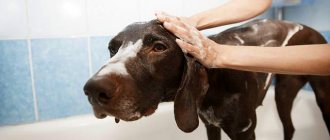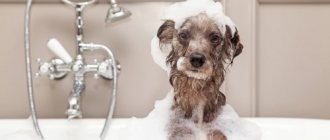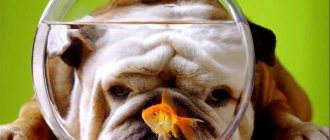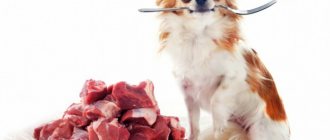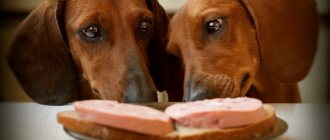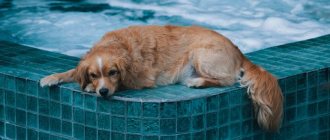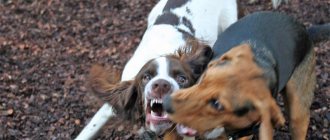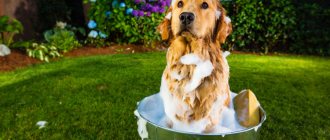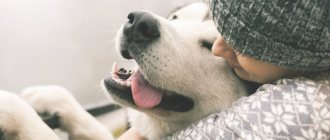On the Internet, and in various clubs for dog breeders, the question is often asked: Is it possible to wash a dog with soap? There is no clear answer to this question. After all, caring for a dog’s fur and skin depends on many factors, such as:
- breed of dog;
- does the animal have allergies;
- what kind of soap and for what purpose are you going to use.
In our article we will try to explain the basic rules for using soap, the harm and benefits of certain types of products.
How often?
Typically, the frequency of washing your pet directly depends on its age, body weight, coat length and time of year. There is an opinion that you need to wash your dog as needed - both when it gets dirty and in the basin. But is it possible, and most importantly, how often should you wash your dog?
After a walk, you can wash your paws every time you return home. After all, no dog wants to listen to complaints from the owner for a soiled carpet or smeared parquet floor. And you don’t need any extra cleaning yourself. But if the time of year and the weather are not rainy, it is quite enough to simply wipe your pet’s paws with a damp cloth and avoid another trip to the bathroom.
How often can you bathe or rinse your handsome dog? In principle, if you rinse your dog with clean water once every 1-2 weeks, there will be no particular harm. But there's no point either. We still do not recommend that you “clean” your dog’s fur too zealously - you can disrupt the functioning of the sebaceous glands and get a problem in the form of a disgusting smell of fish, dog or mushrooms.
We solve problems quickly: why does my dog smell like dog, fish or rotten meat?
But if you come home like this, then immediately run to the bathroom and grab more shampoo!
How many times?
How often, or rather how many times a month, can and should you wash your pet with shampoo? It’s also not worth exhausting your pet with bath procedures every month, since the natural protective fat layer on the dog’s fur will do an excellent job of cleansing it of excess dirt without our help.
The only exceptions in this situation can be exhibitions or any indications from dog handlers or veterinarians.
It is recommended to bathe your dog annually no more than once every 3 months, or even less often. This procedure should not be mandatory and unconditional. Just keep an eye on the condition of your pet’s coat, and if you think it’s necessary, you can give your dog a bath day.
Is it possible...
in winter
Many people ask how often they should wash their pet in winter. In general, strictly speaking, it is not advisable to bathe your pet in winter. Since low air temperatures cannot have a positive effect on your dog, it is better to postpone bathing until the warm season.
Some breeds with thick coats and additional undercoat can take up to two days to dry. And in winter it is incredibly easy for even the largest and fluffiest dog to catch a cold.
After vaccination
After vaccination, your animal’s immunity is weakened, because it is experiencing a fight with new antibodies in its body. Therefore, all veterinarians recommend bathing dogs before vaccination day. A weakened immune system may simply not be able to withstand the next wash and a simple vaccination will become the source of many complications. For such animals, regular combing is recommended, which also perfectly keeps the coat in good condition.
Pregnant
Pregnancy is not considered a disease. However, it is extremely important to protect your dog during this period from negative effects on its body. And if you decide to bathe a pregnant dog, then you will need to adhere to extremely careful manipulations in order to protect it from hypothermia, injury and infections. Since the loop may remain open for some time after mating, it is important to monitor the purity of the water (do not swim in natural bodies of water) and its temperature.
During heat
It is not advisable to bathe your pet during heat, as this can lead to colds of the genitourinary system. If you wash or bathe your dog, it is better to use special disinfectants. However, simply wiping the delicate areas will be quite enough - you will protect yourself from colds and reduce the smell a little.
Head and ears
It is strictly not recommended to water the head, or more precisely the muzzle, with water. If you decide not to avoid this part of the body when bathing, then it is best to simply wipe the face with a damp palm or sponge without soaping it. No matter how hypoallergenic your shampoo is, getting it into your eyes is highly undesirable. Also be careful not to let water get into your ears while swimming. This is fraught with otitis media and other inflammatory diseases.
Before vaccination
If the dog is already old enough, before vaccination it is recommended not only bathing, but also flea treatment, deworming and ear cleaning for ticks. Since the immune system is weakened after vaccination, you are unlikely to be able to give your pet a bath in the near future, so it is more rational to bathe him before going to the veterinary clinic. But still, if this is not necessary, you should not wash the animal again.
Before birth
Before giving birth, bathing a pregnant dog is not particularly recommended. Your animal’s body is too busy with another very important process and is just in the stage of preparation and restructuring, and unnecessary interference in its physiology will only cause additional stress. You don't want to give birth right in the bathroom, do you?
Harmful additives and impurities
Unfortunately, in order to preserve the product, manufacturers often add various harmful additives to shampoos, such as:
- Dietonols (damages the skin and retains harmful substances in the body).
- Phthalates and benzenes (have a detrimental effect on the endocrine and reproductive systems, impotence in men is possible).
- Propylene glycol (irritates the skin, disrupts liver function, causes kidney problems).
- Sulphates SLS . This is an irritant. Penetrates into a person’s eye, his brain, and affects the liver and heart. Slows down organ recovery, causes eye cataracts. Impairs vision in children and is used as a floor cleaner in car washes. SLS is found in many toothpastes and human shampoos. Forms nitrates and dioxins, poisoning the human body.
- Synthetic flavors, etc.
This is harmful to the human body, and even more harmful to the animal, especially when the pet licks it and swallows it. Together with human shampoo, he ingests substances that can cause the most severe diseases.
How?
When choosing a dog wash, carefully read the ingredients. It is best if the shampoo is mild, does not contain aggressive components and does not dry out your pet’s hair and skin. Of course, for each dog, the selection of cosmetics for bathing will be individual, since the choice depends on many factors - hair length, skin sensitivity, allergic reactions of the dog, breed.
According to reviews, Bras shampoo showed good results - in addition, it has a reasonable price.
Study the label: a good shampoo is one with natural ingredients - egg yolk, lecithin, glycerin . You can also make your own shampoo using glycerin, boiled water and essential oils. But remember to be extremely careful when using homemade products.
Is it possible...?
Soap
Using soap on your pet is not recommended, especially not rubbing dry soap onto your pet's fur. This way you can damage the very structure of the villi, and after bathing the dog will take on the appearance of a “sad broom”. Moreover, you can easily dry out your pet’s skin and provoke endless scratching, which very often leads to scratched wounds.
Degtyarny
There is an opinion that tar soap, due to its disgusting smell, can magically rid your dog of fleas and ticks. But that's not true. In fact, apart from troubles with fur, skin and a terrible smell, you will not get anything else. The effectiveness of removing fleas using this procedure is extremely low, therefore using tar soap for such purposes is not recommended . It is better to purchase a special flea and tick shampoo.
Economic
Many people do not risk using laundry soap for their hygiene procedures, let alone dogs. As with other examples, laundry soap will not provide any positive results for your pet. It washes away dirt and grease, thereby destroying the fatty layer of the dog’s coat, which helps it in its natural environment to protect itself from pathogenic bacteria and other microorganisms. Therefore, no laundry soap!
For children
Baby soap is actually very drying for dogs' skin. After all, what is good for a person does not always have a beneficial effect on the animal. The main negative impact of baby soap on your pet's skin may be dandruff and skin irritation. Therefore, if you don’t want your dog to constantly itch and shake heaps of dandruff out of its fur onto your carpets, then put baby soap away from your dog’s bathing cosmetics.
When Head&Shoulders is not a help: dog dandruff
Then the next logical question arises:
Human, regular shampoo
The answer is no, no and no again! Humans and dogs have completely different skin, and regular shampoos for our hair can cause irreparable harm to the health of any dog. The reason is that the acidity of the skin - PH - is lower in dogs than in humans, which indicates more delicate and sensitive skin. Therefore, it is highly not recommended to use human shampoos in dog bathing procedures.
For cats
In principle, shampoo for cats cannot harm a dog when bathing, since cats are more sensitive - they have more delicate skin, and, accordingly, shampoos are more gentle. However, it is better to have your own set of cosmetics for each pet, because if you constantly wash your dog with cat shampoo, you won’t be able to wash the cat with dog shampoo after all, since dog shampoo for a cat can be harmful.
For children
As in the case of baby soap, it’s not worth it. The reason is absolutely the same acidity of the skin. It’s not for nothing that veterinarians recommend washing dogs with shampoos specially designed for them - they take into account all the characteristics of the animals in the composition. Therefore, baby shampoo will also not bring much benefit to the dog; do not be lazy to buy shampoo for puppies if you decide to have a dog in the house.
Compound
Detailed composition of the product:
- fatty acids (palmitic acid gives hardness to a bar of soap, lauric acid promotes high-quality washing even in cold water);
- alkali or otherwise - sodium (provides stain removal when washed);
- kaolin or otherwise - porcelain clay (the presence of this ingredient prevents the negative effects of alkali on human skin);
- rosin (used to increase the shelf life of soap);
- sodium silicate (neutralizes stickiness from rosin);
- lard and soapstock (gives brown color).
Reference. The more fatty acids a soap contains, the better it removes stains, even old ones. Maximum content – 72%.
Conditioner balm
As in the case of shampoo, it is necessary to select other products - conditioners, balms, in accordance with the characteristics of your animal. In addition, you should know what effect this or that product has - there are conditioners that repel dirt, prevent the formation of tangles or remove the static effect.
Read the instructions and composition carefully - the acidity level should correspond to the PH level of your shampoo and pet's coat. It is also necessary to take into account the time of year, because in winter the wool needs additional nutrition; choose a suitable conditioner with a vitamin complex.
General recommendations for caring for a dog (cat)
For temporary use, regular baby soap may be suitable, but for frequent use on humans, it is best not to use on animals. For regular use, we strongly recommend products that have a quality certificate. During daily washing of dogs' paws, the skin and fur can also suffer, in which case it is wiser to purchase a special product that will help avoid this.
Often dog breeders encounter problems such as fleas, ticks, subcutaneous mites, allergies and dermatitis. The right soap will help solve these problems.
Video
Source
Dry shampoo
It can also be a very useful product for dogs. Loose powder products allow you to remove dirt from your pets' fur without using water, and also do not irritate the skin. So, first of all, such a product will be the most convenient to use and is suitable for those who suffer from hypersensitive skin.
And if you are not afraid to experiment at home yourself, then you can make dry shampoo with your own hands , for this you will need:
- baking soda,
- corn starch,
- essential oil.
Prepare a brush, mix all the ingredients and feel free to start cleaning the wool.
Recommendations for cleaning paws
If your pet has been walking on clean soil and its paws are a little “dusty,” then it is better to refuse “chemistry.” Rinsing with warm water is sufficient. In case of severe contamination, it is best to use liquid soap from a pet store. There is a special line for washing paws.
If the “shaggy dirty fellow” takes you by surprise, then you can “arm yourself” with tar. It will also speed up the healing of small wounds and scratches. You can’t wash your paws with household cleaners – there’s too much alkali. Drying will cause cracks to appear.
How to do it right at home?
Detailed instructions on how to wash your dirty little one in the bathroom:
- To make your dog feel comfortable, bring his favorite toys into the bathroom.
- Give her time to get comfortable and get used to the bathroom.
- Play with the stream of water, talk to your pet in a calm voice.
- The dog must stand completely in the bath.
- You can put cotton balls in your ears to prevent moisture from getting in.
- The corners of the eyes are smeared with Vaseline.
- Washing must begin from the withers, and the hair is poured towards the tail.
- The shampoo is also applied from the withers to the tail, paying attention to particularly contaminated areas.
- Use a fairly strong stream of water to remove all the shampoo from the coat, making sure that no foam remains.
- Excess moisture can be removed by hand by squeezing the wool a little.
- Dry the dog with a towel, and if it is not very large, wrap it in it for a short period of time.
- Do not rub the fur intensively with a towel, but blot it - this way you will not harm either the hairs of the dog’s fur or the skin.
- If your pet is not afraid of a hair dryer, dry the fur as much as possible with a cool stream of air.
- After bathing, you should not let your dog go outside for the first few hours to avoid catching a cold.
After the walk
To wash your dog and its paws after a walk, you should simplify the procedure - prepare a small container of water and a brush. After placing your dog on a synthetic mat, thoroughly clean each paw and then wipe dry with a towel.
In fact, you shouldn’t worry too much about exactly how to bathe a dog and wash its paws after a walk - there are no secrets here.
In order to know how to wash your dog’s paws after a walk, you also don’t need to complicate your task too much. First of all, teach your pet that when he enters a room or apartment, he should not run after you and follow you.
Afterwards, carefully examine the paws - if the weather was dry, just wipe the pads and claws with a damp cloth. But if it’s raining outside and lumps of dirt have collected on your paws, you can scrape them off into a bowl, and then wash your paws clean with a sponge or brush. At the end of all procedures, be sure to wipe your paws with a dry towel.
Is it possible to wash your paws with soap? You can't use it for household use, it degenerates a lot of fat. Pet stores sell special liquid soaps for washing paws - you can use them when your paws are really dirty. In general, we repeat, the best thing is to wash off the dust and sediment with simple clean water and a clean wash.
It’s impossible to say exactly how often you need to bathe your dog after going outside - it all depends on how piggy your dog is.
